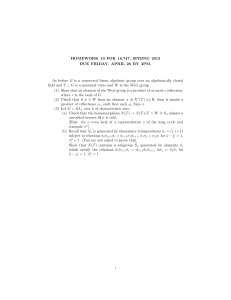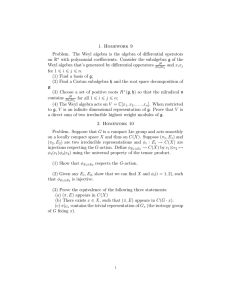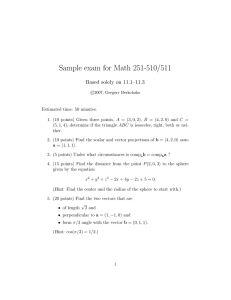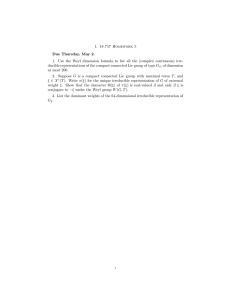Steps in Differential Geometry, Proceedings of the Colloquium
advertisement
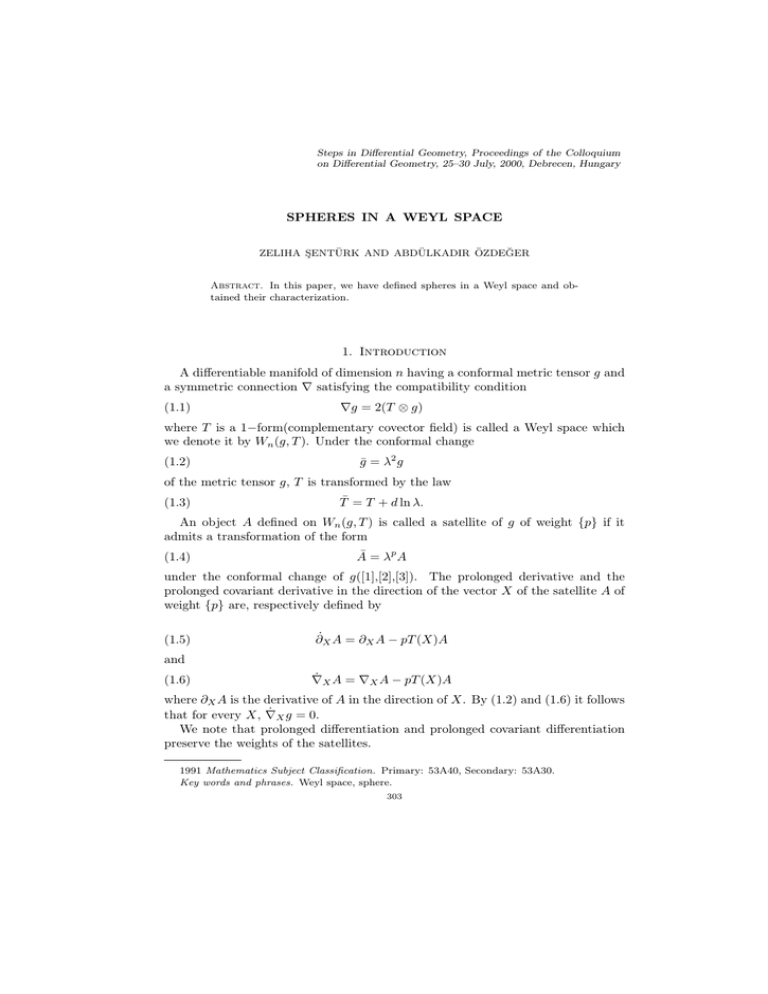
Steps in Differential Geometry, Proceedings of the Colloquium
on Differential Geometry, 25–30 July, 2000, Debrecen, Hungary
SPHERES IN A WEYL SPACE
ZELIHA ŞENTÜRK AND ABDÜLKADIR ÖZDEĞER
Abstract. In this paper, we have defined spheres in a Weyl space and obtained their characterization.
1. Introduction
A differentiable manifold of dimension n having a conformal metric tensor g and
a symmetric connection ∇ satisfying the compatibility condition
(1.1)
∇g = 2(T ⊗ g)
where T is a 1−form(complementary covector field) is called a Weyl space which
we denote it by Wn (g, T ). Under the conformal change
(1.2)
ḡ = λ2 g
of the metric tensor g, T is transformed by the law
(1.3)
T̄ = T + d ln λ.
An object A defined on Wn (g, T ) is called a satellite of g of weight {p} if it
admits a transformation of the form
(1.4)
Ā = λp A
under the conformal change of g([1],[2],[3]). The prolonged derivative and the
prolonged covariant derivative in the direction of the vector X of the satellite A of
weight {p} are, respectively defined by
(1.5)
∂˙X A = ∂X A − pT (X)A
and
(1.6)
˙ X A = ∇X A − pT (X)A
∇
where ∂X A is the derivative of A in the direction of X. By (1.2) and (1.6) it follows
˙ X g = 0.
that for every X, ∇
We note that prolonged differentiation and prolonged covariant differentiation
preserve the weights of the satellites.
1991 Mathematics Subject Classification. Primary: 53A40, Secondary: 53A30.
Key words and phrases. Weyl space, sphere.
303
304
ZELIHA ŞENTÜRK AND ABDÜLKADIR ÖZDEĞER
Let x ∈ U ⊂ Wn (g, T ), X ∈ Tx (U ), A ∈ χ(U ), and let X =
Pn
Pn
∂
k
A = i=1 Ai ∂x
i, T =
k=1 Tk dx . Then (1.6) gives
(1.7)
˙ k Ai = X k ∇k Ai − pTk Ai , ∇k = ∇
Xk∇
∂
∂xk
Pn
k=1
X k ( ∂x∂ k )x ,
.
Spheres in Riemannian spaces are extensively studied by K.Yano and K.Nomizu
[4].
The definition of a sphere given in a Riemannian space is not applicable in a Weyl
space since the length of a vector field is not a gauge invariant. In the following we
use the prolonged covariant differentiation in the definition of a sphere in a Weyl
space due to the fact that it preserves the metric tensor and the weights of the
satellites.
As far as we know, spheres in Weyl spaces have not yet been studied.
¯ be the
Let Wn (g, T ) be a subspace of the Weyl space W̄m (ḡ, T̄ ) and let ∇ and ∇
corresponding connections. Let pεWn (g, T ) and let U , Ū be the special coordinate
neighborhoods of p. Then, the Gauss equation and the Weingarten equation for
Wn (g, T ) are respectively
¯ X̄ Ȳ |U = ∇
¯ X Y = ∇X Y + α(X, Y )
(1.8)
∇
(1.9)
¯U = ∇
¯ X̄ ξ|
¯ X ξ = −Aξ X + ∇⊥
∇
Xξ
where XεTp (U ), Y εχ(U ) and ξ is a vector field normal to Wn (g, T ) while X̄, Ȳ
are extensions of X ve Y to Ū [5].
We now find the expressions for Gauss and Weingarten equations in terms of
prolonged covariant derivative. The prolonged covariant derivative of the vector
field Y εχ(U ) of weight {−1} in the direction of X is, according to (1.6)
¯˙ X Y = ∇
¯ X Y + T̄ (X)Y.
∇
(1.10)
¯˙ X Y = ∇X Y +α(X, Y )+ T̄ (X)Y from which it follows
By (1.8), (1.10) becomes ∇
that
¯˙ Y = ∇ Y + T̄ (X)Y = ∇
˙ Y
tan∇
X
¯˙ X Y
nor∇
X
X
= α(X, Y )
and consequently we have
(1.11)
¯˙ X Y
∇
¯˙ Y
∇
X
¯˙ X Y + nor∇
¯˙ X Y
= tan∇
˙ X Y + α(X, Y ).
= ∇
Similarly, the normal vector field ξ of weight {−1} has the prolonged covariant
derivative
¯˙ X ξ = ∇
¯ X ξ + T̄ (X)ξ
(1.12)
∇
in the direction of X. By the Weingarten equation (1.9), (1.12) takes the form
¯˙ X ξ = −Aξ X + ∇⊥
∇
X ξ + T̄ (X)ξ.
SPHERES IN A WEYL SPACE
305
Since
(1.13)
¯˙ X ξ
tan∇
¯˙ ξ
nor∇
X
= −Aξ X,
= ∇⊥
X ξ + T̄ (X)ξ,
(1.12) reduces to
¯˙ X ξ
∇
¯˙ ξ
∇
X
¯˙ X ξ + nor∇
¯˙ X ξ
= tan∇
= −Aξ X + ∇⊥
X ξ + T̄ (X)ξ,
or
(1.14)
¯˙ X ξ = −Aξ X + ∇
˙⊥
∇
X ξ.
A normal vector field ξ on Wn (g, T ) is said to be parallel with respect to ∇⊥
X if
∇⊥
Xξ = 0
(1.15)
for every tangent vector X.
The vector field
(1.16)
η=
1
trα
n
is called the mean curvature vector of Wn (g, T ).
Let C be a smooth curve belonging to the Weyl space Wn (g, T ) and let ξ1 be
the tangent vector to C at the point P normalized by the condition g(ξ1 , ξ1 ) = 1. A
curve in Wn (g, T ) is called a circle if there exist a vector field ξ2 , normalized by the
condition g(ξ2 , ξ2 ) = 1, along C and a positive prolonged covariant constant scalar
function κ of weight {−1} such that
(1.17)
˙ ξ = κξ
∇
2
ξ1
1
(1.18)
˙ ξ = −κξ .
∇
1
ξ2
1
We note that the equations (1.17) and (1.18) are invariant under a gauge transformation.
A circle C satisfies the third order differential equation
(1.19)
i
˙ 2 ξ + g(∇
˙ ξ,∇
˙ ξ )ξ = 0 , ξ i = dx
∇
1
ξ1 ξ1 1
ξ1
ds
1
1
1
where s is the arclength of C measured from a fixed point on C and xi are the
coordinates of a current point belonging to C [6].
306
ZELIHA ŞENTÜRK AND ABDÜLKADIR ÖZDEĞER
2. SPHERES IN A WEYL SPACE
Let Wn (g, T ) be a submanifold of a Weyl space W̄m (ḡ, T̄ ). In this section the
concept of a sphere in Riemannian space will be generalized to a Weyl space.
Definition 1. If Wn (g, T ) is an n-dimensional umbilical submanifold of the mdimensional Weyl space W̄m (ḡ, T̄ ) with a non-zero curvature vector then it is called
an extrinsic sphere or simply a sphere.
Theorem 1. Let Wn (g, T ) (n ≥ 2) be a submanifold of the Weyl space W̄m (ḡ, T̄ ).
If every circle in Wn (g, T ) is a circle in W̄m (ḡ, T̄ ), then Wn (g, T ) is a sphere in
W̄m (ḡ, T̄ ). Conversely, if Wn (g, T ) is a sphere in W̄m (ḡ, T̄ ), then every circle in
Wn (g, T ) is a circle in W̄m (ḡ, T̄ ).
Proof. Let x be an arbitrary point of Wn (g, T ) and ξ, η orthonormal vectors in
the tangent space of Wn (g, T ) at x. Let C be a curve admitting a parametric
representation x = x(s). We now take the arc length (|s| < ε) as a parameter for
the curve C. Let the curve C be a circle in the submanifold Wn (g, T ) such that
˙ ξ |0 = 1 η
x(0) = x0 = x , ξ(0) = ξ0 = ξ , ∇
ξ1
r
1
(2.1)
where ξ1 is a tangent vector of the circle C.
Since C is a circle, the vector ξ1 satisfies the differential equation
˙ 2 ξ + g(∇
˙ ξ,∇
˙ ξ ξ
∇
ξ 1 ξ 1 ) 1 = 0.
ξ1
(2.2)
1
1
1
¯ the connection of W̄m (ḡ, T̄ ), if the curve C in Wn (g, T ) is a circle
Denoting by ∇
in W̄m (ḡ, T̄ ), then we have
¯˙ 2 ξ + g(∇
¯˙ ξ , ∇
¯˙ ξ ξ
∇
ξ 1 ξ 1 ) 1 = 0.
ξ1
(2.3)
1
1
1
Denoting by α the second fundamental form of Wn (g, T ) and using the Gauss
equation (1.11) we get
¯˙ ξ = ∇
˙ ξ + α(ξ , ξ ).
∇
1 1
ξ1
ξ1
(2.4)
1
1
Taking the prolonged covariant derivative of (2.4) in the direction of ξ1 we obtain
¯˙ 2 ξ
∇
ξ1
1
¯˙ (∇
˙ ξ
¯˙
ξ ξ
= ∇
ξ ξ 1 ) + ∇ξ α( 1 , 1 )
1
1
1
˙ 2 ξ + α(ξ , ∇
˙ ξ)−A
˙ ⊥ α(ξ , ξ )
ξ +∇
= ∇
1
ξ1
ξ1
ξ 1 1
α(ξ ,ξ ) 1
(2.5)
1
1
1 1
1
˙ ⊥ denotes the prolonged
where Aξ is the shape operator for a normal vector ξ and ∇
covariant differentiation along C relative to the normal connection. Substituting
(2.4) and (2.5) into (2.3) and taking account of (2.2) we get
(2.6)
˙ ξ)−A
˙ ⊥ α(ξ , ξ ) + g(α(ξ , ξ ), α(ξ , ξ ))ξ = 0.
ξ +∇
α(ξ1 , ∇
1 1
1 1 1
ξ1
ξ 1 1
α(ξ ,ξ ) 1
1
1 1
1
SPHERES IN A WEYL SPACE
307
Separating (2.6) into tangential and normal components , we get respectively
A ξ ξ ξ1 = g(α(ξ1 , ξ1 ), α(ξ1 , ξ1 ))ξ1
α( , )
(2.7)
1 1
and
˙ ξ)+∇
˙ ⊥ α(ξ , ξ ) = 0.
α(ξ1 , ∇
ξ1
ξ 1 1
(2.8)
1
1
Using
˙ ⊥ α(ξ , ξ ) − 2α(∇
˙ ξ,ξ)
˙ ∗ α)(ξ , ξ ) = ∇
(∇
1 1
ξ1 1
ξ
ξ 1 1
(2.9)
1
1
1
we may rewrite (2.8) in the form
˙ ξ , ξ ) = −(∇
˙ ∗ α)(ξ , ξ ) ,
3α(∇
1 1
ξ1 1
ξ
(2.10)
1
1
˙ ∗ α is the Weyl version of the natural covariant derivative of the second
where ∇
ξ
1
fundamental form α in the direction of ξ1 in the Riemannian case [7].
˙ ξ |0 = 1 η and using (2.2) we obtain
Noting that ∇
r
ξ1
1
r ˙∗
α)(ξ, ξ).
α(η, ξ) = − (∇
3 ξ1
(2.11)
This equation shows that α(η, ξ) is independent of η provided that η is orthogonal to ξ. In particular changing η into −η we find α(η, ξ) = 0 .
To complete the proof of the theorem we now establish the
Lemma Let x be an arbitrary point of Wn (g, T ), and let ξ, η be orthonormal
vectors in the tangent space of Wn (g, T ) at x so that α(ξ, η) = 0. Then the
following conclusions hold:
(1) α(ξ, ξ) = α(η, η) for any orthonormal ξ and η in Tx (Wn ).
(2) The mean curvature vector ηx is equal to α(ξ1 , ξ1 ), where ξ1 is an arbitrary
vector in Tx (Wn ) normalized by the condition g(ξ1 , ξ1 ) = 1.
(3) Wn (g, T ) is umbilical at x , i.e.
α(ξ, η) = g(ξ, η)ηx ,
for all ξ, η ∈ Tx (Wn ).
Proof.
(1) Since ξ and η are orthonormal, so are
√1 (ξ
2
+ η) and
√1 (ξ
2
− η). Thus
1
1
α( √ (ξ + η), √ (ξ − η)) = 0
2
2
which implies that
α(ξ, ξ) = α(η, η).
(2) Let {ξ1 , ξ2 , ..., ξn } be an orthonormal basis in Tx (Wn ).By (1)
α(ξ1 , ξ1 ) = α(ξ2 , ξ2 ) = ... = α(ξn , ξn ).
308
ZELIHA ŞENTÜRK AND ABDÜLKADIR ÖZDEĞER
Therefore we find
n
1X ξ ξ
α( , ) = α(ξ1 , ξ1 ).
n i=1 i i
ηx =
(3) Since {ξ1 , ξ2 , ..., ξn } is an orthonormal basis we can write
ξ=
n
X
ai ξi and η =
i=1
n
X
bi ξi .
i=1
So that
α(ξ, η)
n
X
=
ai bj α(ξi , ξj ) = (
i,j=1
n
X
ai bi )α(ξ1 , ξ1 )
i=1
= g(ξ, η)ηx .
˙ ξ ) = 0 we have α(ξ , ∇
˙ ξ ) = 0.
Now we go back to the theorem. Since g(ξ1 , ∇
1
ξ1
ξ1
1
1
Thus (2.8) gives
˙ ⊥ α(ξ , ξ ) = 0.
∇
ξ 1 1
(2.12)
1
By (2) of the lemma we know that α(ξ1 , ξ1 ) is equal to the mean curvature vector
ηx along the curve C. (2.12) means that
˙ ⊥ η = 0.
∇
ξ
(2.13)
1
Since x and ξ1 are arbitrary we have shown that the mean curvature vector η of
Wn (g, T ) is parallel. Thus Wn (g, T ) is a sphere.
Conversely, assume that Wn (g, T ) is a sphere in W̄m (ḡ, T̄ ) and the curve C is a
circle in Wn (g, T ). In this case the differential equation (2.2) is satisfied.
Since Wn (g, T ) is umbilical, we have
α(ξ1 , ξ1 ) = g(ξ1 , ξ1 )ηx = ηx .
(2.14)
From (2.4) and (2.3) we get
(2.15)
2
¯˙ ξ , ∇
¯˙ ξ
˙ ξ ˙ ξ
g(∇
ξ 1 ξ 1 ) = g(∇ξ 1 , ∇ξ 1 ) + H
1
1
1
1
where H =k ηx k is the mean curvature.
In (2.6) we have
˙ ξ ) = g(ξ , ∇
˙ ξ )ηx = 0
α(ξ1 , ∇
1
ξ1
ξ1
1
1
A ξ ξ ξ1 = Aηx ξ1 = H 2 ξ1 .
α( , )
1 1
Since η is parallel we obtain
˙ ⊥ α(ξ , ξ ) = ∇
˙ ⊥ ηx = 0.
∇
ξ 1 1
ξ
1
1
SPHERES IN A WEYL SPACE
309
Thus (2.5) reduces to
(2.16)
¯˙ 2 ξ = ∇
˙ 2 ξ − H 2ξ .
∇
1
ξ1
ξ1
1
1
The equation (2.3) is satisfied as a consequence of (2.2), (2.15) and (2.16). Thus
the curve C is a circle in W̄m (ḡ, T̄ ).
References
[1] Hlavaty, V., Theorie d’immersion d’une Wm dans Wn , Ann. Soc. Polon. Math., V.21, 196-206,
1949.
[2] Norden, A., Affinely Connected Spaces, GRMFL Moscow, 1976.
[3] Zlatanov, G. and Tsareva, B. On the Geometry of the Nets in the n-dimensional space of
Weyl, Journal of Geometry, Vol.38, 182-197, 1990.
[4] Nomizu, K., Yano, K. On Circles and Spheres in Riemannian Geometry, Math. Ann, 170,
163-170, 1974.
[5] Pedersen, H., Poon, Y.S., Swann, A. Einstein-Weyl Deformations and Submanifolds, A. to
appear in the International Journal of Mathematics, 1999.
[6] Özdeğer, Abdülkadir; Şentürk, Zeliha; Circles In Weyl Spaces And Their Conformal Mapping,
preprint, 2000
[7] Nomizu, K., Sasaki, T., Affine Differential Geometry, Cambridge University Press, Cambridge,
1994.
Istanbul Technical University, Faculty of Science and Letters , Mathematics Department, 80626, Maslak ,Istanbul
E-mail address: gulerz@itu.edu.tr
E-mail address: ozdeger@itu.edu.tr
